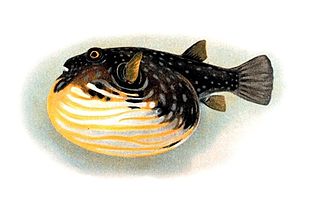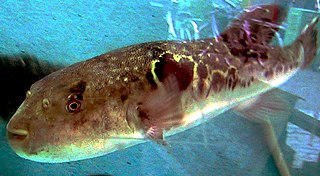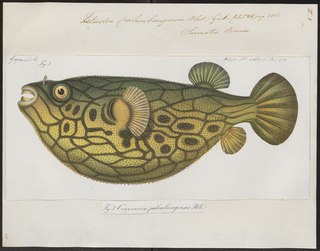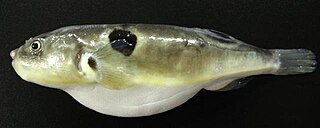
Tetraodontidae is a family of primarily marine and estuarine fish of the order Tetraodontiformes. The family includes many familiar species variously called pufferfish, puffers, balloonfish, blowfish, blowers, blowies, bubblefish, globefish, swellfish, toadfish, toadies, toadle, honey toads, sugar toads, and sea squab. They are morphologically similar to the closely related porcupinefish, which have large external spines. The scientific name refers to the four large teeth, fused into an upper and lower plate, which are used for crushing the hard shells of crustaceans and mollusks, their natural prey.

Takifugu, also known by the Japanese name fugu, is a genus of pufferfish with 25 species, most of which are native to salt and brackish waters of the northwest Pacific, but a few species are found in freshwater in Asia or more widely in the Indo-Pacific region. Their diet consists mostly of algae, molluscs, invertebrates and sometimes crustaceans.

The Mbu pufferfish, also known as Mbuna pufferfish, giant pufferfish, or giant freshwater pufferfish, is a carnivorous freshwater pufferfish originating from the middle and lower sections of the Congo River in Africa, as well as the east coast of Lake Tanganyika near the Malagarasi River mouth.

The fahaka pufferfish, also known as the Nile puffer, globe fish, lineatus puffer, is a tropical freshwater pufferfish found in the upper Nile, Chad, Senegal, Gambia, Geba, Volta and Turkana basins in West, Northeast and East Africa.

The dwarf pufferfish, also known as the Malabar pufferfish, pygmy pufferfish, or pea pufferfish, is a small freshwater pufferfish endemic to Kerala and southern Karnataka in Southwest India. They are popular in aquaria for their bright colours and small size. At a maximum length of 3.5 cm, dwarf pufferfish are one of the smallest pufferfish in the world. They closely resemble the related Carinotetraodon imitator, and the two can be difficult to distinguish. C. imitator was not recognised as a different species until 1999.

Takifugu rubripes, commonly known as the Japanese puffer, Tiger puffer, or torafugu, is a pufferfish in the genus Takifugu. It is distinguished by a very small genome that has been fully sequenced because of its use as a model species and is in widespread use as a reference in genomics.
Pao cochinchinensis is a species of freshwater pufferfish native to the basins of the Mekong and Chao Phraya Rivers. This species grows to a length of 7 centimetres (2.8 in) SL.

The green pufferfish or Ceylon pufferfish is a species of pufferfish found in South and Southeast Asia. Its habitat includes rivers, estuaries, lakes and flood plains. It lives in fresh to slightly brackish water.

Pao palembangensis, is a species of freshwater pufferfish native to Thailand, Laos, Malaysia and Indonesia in Southeast Asia. Its commonly called the humpback puffer or dragon puffer. It is bred for aquaria as an ornamental fish because of its beautiful skin colouration and pattern.

Chonerhinos naritus, the bronze pufferfish or yellow pufferfish, is a species of pufferfish native to Southeast Asia, where mainly found in estuarine and coastal habitats. This species grows to a length of 28.5 centimetres (11.2 in) TL, but otherwise it generally resembles the smaller and more strictly freshwater Auriglobus pufferfish. This predatory species feeds on other fish, crustaceans and snails.
Pao turgidus is a species of freshwater pufferfish native to the Mekong basin. It may also occur in the Chao Phraya basin in Thailand. This species grows to a length of 18.5 centimetres (7.3 in) SL.

Takifugu obscurus or the obscure pufferfish is a species of euryhaline, anadromous pufferfish first described by T. Abe in 1949. It has been categorized by the IUCN as a least-concern species globally since 2014; in South Korea, it is however classified as an endangered species due to overfishing of its endemic populations. The Catalogue of Life lists no subspecies of Takifugu obscurus. The species prefers deeper, clearer areas of brackish and fresh water, and is found in estuaries, as well as rivers and tributaries thereof such as the South Korean rivers Geum, Han, and Imjin, or the Tamsui River. The species is endemic to North and South Korea, the Sea of Japan, and the East and South China Seas. Uses of Takifugu obscurus include human consumption, use in animal testing, and owning specimens as pets. As with most species of pufferfish, several organs of Takifugu obscurus contain tetrodotoxin, making it potentially poisonous if not prepared safely by trained persons.
Auriglobus amabilis is a species of pufferfish in the family Tetraodontidae. It is a tropical freshwater species known only from Indonesia. The species reaches 7 cm SL and feeds almost exclusively on large aquatic insect larvae. It was originally included in the genus Chonerhinos alongside the four other species now included in Auriglobus, although the only remaining member of the former genus, C. naritus, differs from Auriglobus by being larger and not an exclusively freshwater fish.
Auriglobus remotus is a species of pufferfish in the family Tetraodontidae. It is a tropical freshwater species known only from Indonesia that reaches 6.2 cm SL. Like the other four members of Auriglobus, it was previously classified in the genus Chonerhinos.
Auriglobus silus is a species of pufferfish in the family Tetraodontidae. It is a tropical freshwater fish known only from Indonesia that reaches 8.2 cm SL. Like the other four members of Auriglobus, it was previously classified as a species of Chonerhinos.

Canthigaster punctatissima, known as the spotted sharpnose puffer or the spotted sharpnosed puffer, is a species of pufferfish in the family Tetraodontidae. It is native to the Eastern Pacific, where it ranges from Guaymas, Mexico to Panama and the Galápagos Islands. It is replaced by its close relatives C. janthinoptera and C. jactator in the Western Pacific and the Hawaiian Islands, respectively. It is found in sheltered areas of rocky reefs at a depth range of 3 to 21 m and reaches 9 cm in total length. The species is reported to be monogamous.
Chelonodon dapsilis, known as the plentiful toby, is a species of pufferfish in the family Tetraodontidae. It is native to the Western Pacific, where it is endemic to Australia. It is a tropical fish found in both marine and brackish environments, being known from coastal estuaries, mangrove swamps, and sandy areas in marine waters. The species is reported to be oviparous. ITIS lists this species as a member of the genus Leiodon, although WoRMS and FishBase both include it within Chelonodon. It was first described by Gilbert Whitley in 1943, from a specimen collected from the Fitzroy River, in Queensland.

Chelonodontops patoca, also known as the milk-spotted pufferfish, milkspotted puffer, milkspotted toadfish, Gangetic blow fish, Gangetic pufferfish, or marbled toad, is a species of pufferfish in the family Tetraodontidae native to the Indo-Pacific. It ranges from East Africa to the Western Pacific from Korea in the north to northern Australia in the south. It is a tropical species that occurs in coastal waters, lagoons, estuaries, and rivers. While it does enter fresh water, the species does not occur more than a few kilometres from the sea. It is often seen in schools which sometimes enter freshwater streams. It is usually found at a depth range of 4 to 60 m and reaches 38 cm (15 in) standard length. The species is poisonous but reportedly considered a delicacy in Japan.
Takifugu coronoidus is a species of pufferfish in the family Tetraodontidae. It is a brackish-water species known from China that was first described by Y. Li and C. S. Ni in 1992. In Chinese, the species is known as "晕环多纪鲀", which translates to "halo pufferfish".
Torquigener marleyi is a species of pufferfish in the family Tetraodontidae. It is a marine species known only from South Africa, where it occurs near the Tugela River in KwaZulu-Natal. FishBase lists this species as a synonym of Torquigener balteus, although ITIS and WoRMS list it as a valid species.










